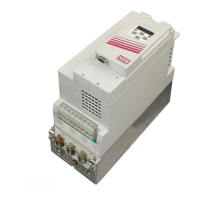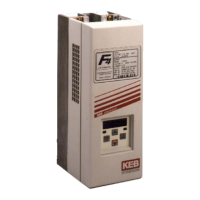Do you have a question about the KEB COMBIVERT 14F5 Series and is the answer not in the manual?
Explains hazard signal words and symbols used in the manual for safety.
Lists additional symbols used in the manual for navigation and information.
Outlines EC declaration of conformity, CE mark, and website information.
Details warranty and liability terms based on general sales conditions.
Provides information on requesting further details or assistance from KEB.
States usage rights for documentation and acknowledges third-party software.
Specifies that the manual is for qualified electrical personnel with specific knowledge.
Provides guidelines for safe transport, storage, and handling of the drive converters.
Covers safety precautions and general requirements for installing the drive converter.
Details safety warnings and requirements for electrical installation and connection.
Lists safety instructions for initial start-up, operation, and potential hazards.
Outlines required maintenance tasks to be performed by authorized personnel.
Warns against unauthorized repairs and specifies using original manufacturer parts.
Explains the proper disposal procedures for electronic devices according to regulations.
Lists key features of the COMBIVERT F5-AIC, such as voltage conversion and regeneration.
Lists necessary components and configurations for operation, like AIC/LCL filters.
Defines the intended use of the F5-AIC as a power supply and regenerative unit.
Lists potential residual risks like wrong direction of rotation or overspeed.
Prohibits the operation of other electric consumers with the device.
Explains the structure of the part code for different configurations and options.
Details operating conditions including climatic environmental conditions.
Lists environmental conditions for storage, transport, and operation like temperature and humidity.
Specifies mechanical conditions for storage, transport, and operation, including vibration and shock limits.
Lists requirements regarding contamination by gases, solids, and active substances.
Covers device classification and electromagnetic compatibility requirements.
Describes how the overload integrator functions and triggers the E.OL error.
Lists available accessories such as AIC, LCL, and EMC filters.
Details AIC/LCL and EMC filters, including size, housing, cooling, and material numbers.
Explains the function of common mode filters and lists associated filter combinations.
Lists DC fuses, including assembly kits, fuse bodies, voltage, and current ratings.
Describes the requirement and specifications for an external precharging resistor.
Refers to separate manuals for detailed dimensions and terminal descriptions.
Provides a diagram and list for EMC-compatible installation within a control cabinet.
Lists essential installation instructions for proper setup and safety.
Explains the function of various terminals for input and output connections.
Details terminal assignments for different housing types (E, G, H, R, U, P).
Provides a table for permissible wire cross-sections and tightening torques for terminals.
Shows connection details for external fan supply for specific housing types.
Explains how to connect KTY or PTC sensors for temperature monitoring.
Illustrates circuit diagrams for different drive converter types (A1, A2, D1).
Presents circuit examples for power units, master-slave configurations, and control circuits.
Details the assignment of the terminal block X2A on the control board.
Lists PIN, Function, Name, Default assignment, and Description for terminal block X2A.
Provides guidelines for connecting the control to prevent malfunctions from interference.
Shows wiring examples for digital inputs using internal or external voltage supply.
Explains analog input settings and shows diagrams for external and internal setpoint settings.
Describes the voltage input for external power supply and the sequence of switching on.
Shows digital outputs and their maximum current rating.
Details relay outputs and specifies the need for protective circuits for inductive loads.
Shows analog outputs with their voltage and current specifications.
Describes the voltage output for controlling digital inputs and external elements.
Describes how to operate the COMBIVERT using a special HSP5 cable and software.
Explains the use of the digital operator for local control and parameterization.
Details keyboard operation for parameter navigation, value changes, and error resetting.
Details the interface operator's functionality and its extensions.
Explains the HSP5 interface (X6B) for diagnostic and programming via PC.
Describes the RS232/485 interface X6C, including pin assignments and signal meanings.
Provides instructions for connecting via RS485 interface to prevent malfunctions.
Provides guidance on dimensioning the COMBIVERT F5 AIC based on input current and voltage.
Lists technical data for COMBIVERT drive converters, including precharging and charging currents.
Presents specific technical data for COMBIVERT F5 AIC devices, including charging currents.
Covers installation procedures and requirements for liquid-cooled drive converters.
Specifies design systems, materials, max operating pressure, and connecting ducts.
Discusses material selection for the cooling circuit to prevent corrosion and pitting.
Details standards, pH value, abrasive substances, and water types for coolant.
Addresses maximum flow and overheat temperatures, and their relation to technical data.
Provides instructions for connecting the coolant circuit, emphasizing flow direction and tightness.
Shows a diagram illustrating pressure drop based on flow rate for different module configurations.
Presents connection schemes for master/slave and master/slave/slave systems in series.
Displays a graph relating volume flow to heat dissipation and temperature difference.
Illustrates a parallel connection scheme for the cooling circuit.
Describes the process for emptying the cooling circuit for longer periods of inactivity.
Lists product standards directly applicable to the drive converter, e.g., EN61800 series.
Lists basic standards referenced by drive converter standards, e.g., EMC and insulation coordination.
Lists standards relevant to the installation environment, such as electrical installations and safety.











